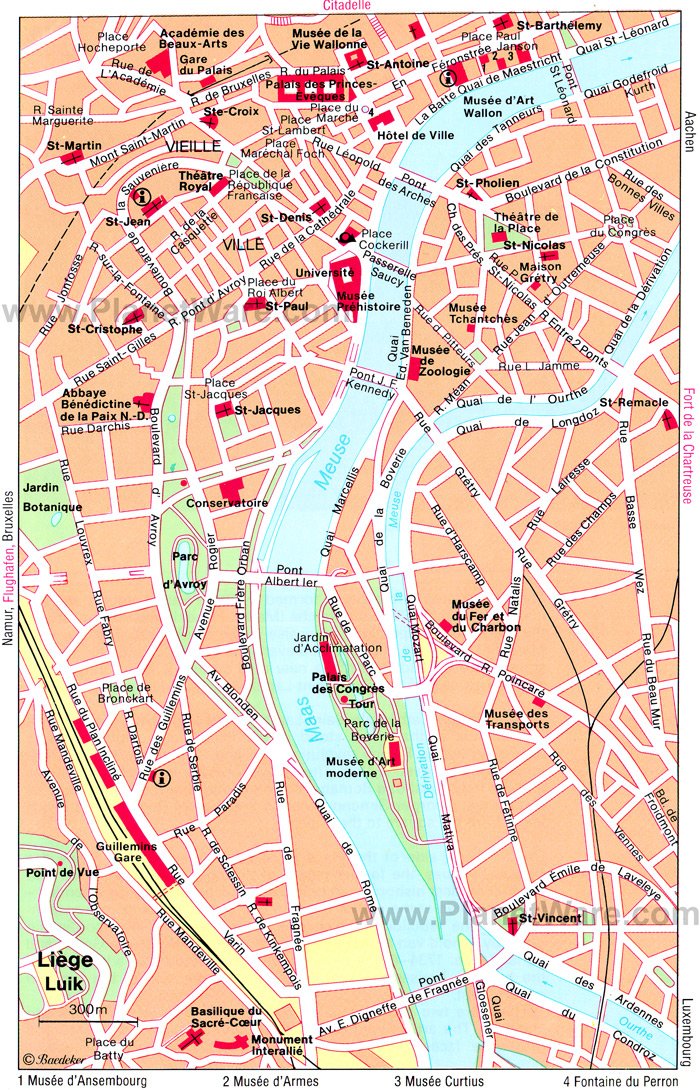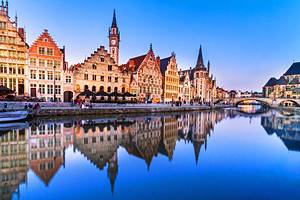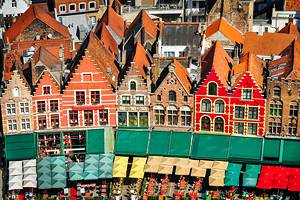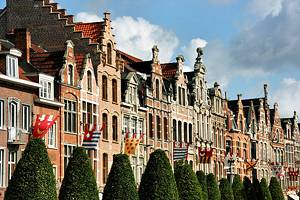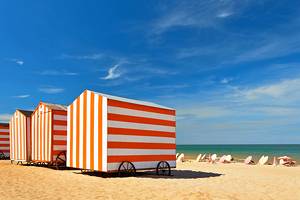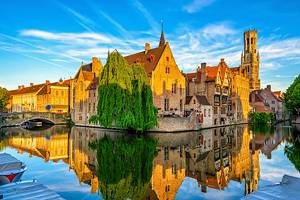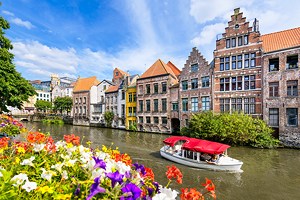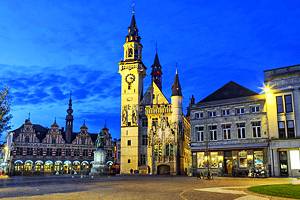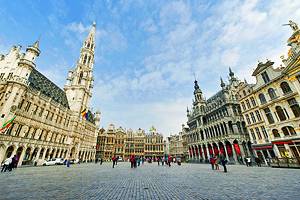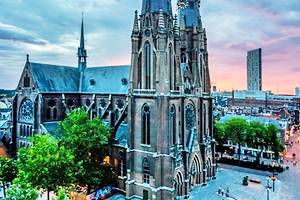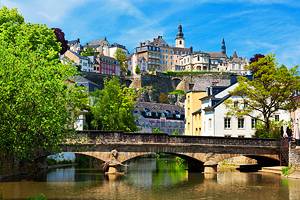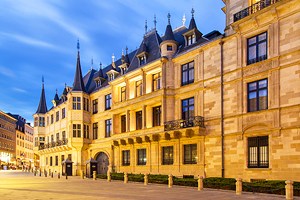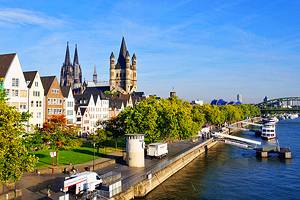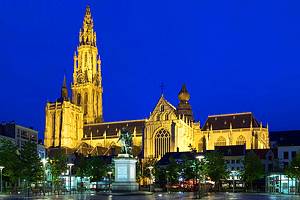Attractions & Things to Do in Liège
Liège (Luik in Flemish) is Belgium's third-largest municipality by population after Antwerp and Ghent, and has historically been one of the country's most important industrial centers. It was one of the first places in Europe to start mining coal, and it has a long tradition of manufacturing, particularly in the steel industry.
Due to this industrial heritage, Liège isn't as pretty as other Belgian towns (such as Bruges and Ghent), but it does have some absolutely wonderful museums, churches, and cultural tourist attractions that those with an interest in architecture, art, and history will appreciate. In particular, visitors shouldn't miss the fantastic La Boverie and the Grand Curtius Museums, two of the country's best museums.
Climb the Montagne de Bueren
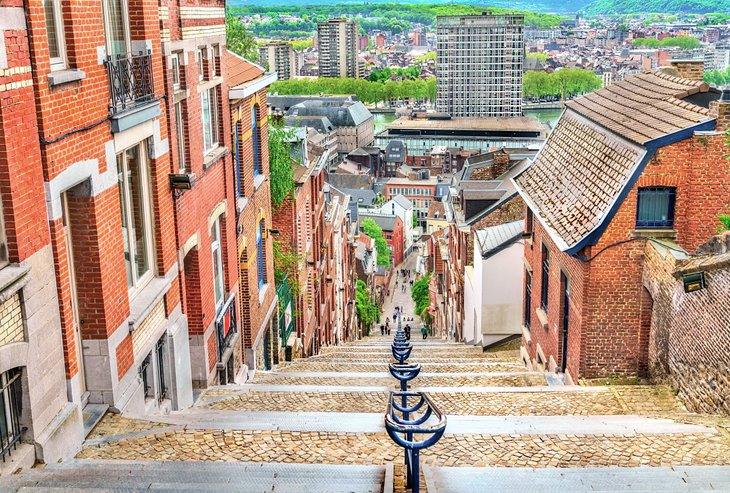
Tourists visiting Liège can't miss the Montagne de Bueren (Bueren Mountain), a massive set of 374 steps, which rise at a 30 percent incline. The stairs are Liège's most defining landmark, and taking the knee-wearying route up them is one of the city's major tourist attractions.
Built in 1881, the steps were constructed to give soldiers in the citadel quick and (somewhat) easy access to the center of town in the event that they were needed to defend the city.
The steps are just one of the numerous paths found on the Coteaux de la Citadelle, the historic hillside of Liège's citadel. Those planning on making the climb will be well-rewarded at the top, with breathtaking panoramic views of the city below and the surrounding landscape.
Those lucky enough to visit in June of an even-numbered year can admire the creative "Beuren en Fleur," when the steps are adorned with colorful flowers. During October's Nocturne des Coteaux de la Citadelle celebrations, the steps are lined with candles, creating a stunning sight in the evening.
Address: Rue Montagne de Bueren, 4000 Liège
Tour the Museums of the Grand Curtius (formerly Museums of the Quai de Maestricht)

The Maestricht Quay (Quai de Maestricht) neighborhood, on the riverbank, is a good place to head if you want to delve into some local history, as it is home to a selection of interesting museums.
The Arms Museum (Musée d'Armes), Curtius Museum (Musée Curtius), and Glass Museum (Musée du Verre) were once standalone museums; they have all been integrated into a single, large museum complex known as the Grand Curtius Museum.
This complex is the former mansion of Jean Curtius (1551-1628), once a supplier to the Spanish army. Between 1600 and 1610, he had this exemplary red brick house built on the riverbank in the style of the Mosan Renaissance.
The Curtius Museum contains exhibits from prehistoric, Roman, and Frankish-Medieval periods, together with furniture and decorative art collections from the Middle Ages to the French Revolution. The Glass collection comprises over 10,000 glass exhibits spanning from the 5th century BC to the present, including highly original Art Nouveau glasses and vases.
The Arms collection boasts a magnificent treasure of small arms, documenting the tradition of weapons manufacture in Liège that dates back to the 14th century.
Address: Quai de Maestricht, Liège
Visit the Convent Church of Saint-Paul
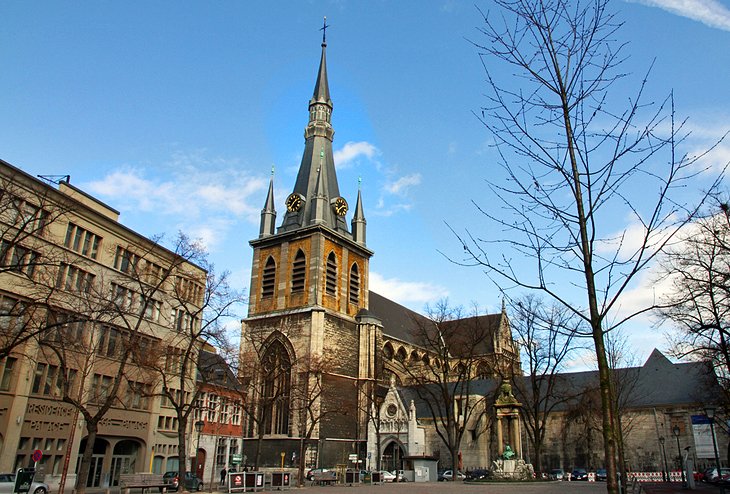
In Liège's Place de la Cathédrale stands the former Convent Church of Saint-Paul, founded by Bishop Heraclius in 971.
The decoration of the expansive interior (85 meters long, 34 meters wide, and 24 meters high) took place between the 16th and 19th centuries and encompasses works such as the marble sculpture of the burial of Christ by Delcour in the left side aisle, a large glass window by Hans of Cologne (1530) in the right hand aisle, and other examples of artistic stained glass from 1557-1587 in the choir apse.
The Treasury in the adjoining cloisters possesses two outstanding works. The one-and-a-half-meter-high reliquary of St. Lambert was made in 1506 to 1512 by Hans von Reutlingen, the goldsmith of Emperor Maximilian and Charles V. While the gold reliquary of Charles the Bold depicts the Duke of Burgundy.
This work of art by Gérard Loyet in 1467 was allegedly a gift to the city of Liège from Charles the Bold in 1471 as an expression of regret at the destruction of the city, which he had ordered.
Address: Place de la Cathédrale, Liège
Parc Boverie and La Boverie Museum

Liège's largest public green space, Parc Boverie was created in 1874 to provide a peaceful place to enjoy nature. Nestled in the V formed by the confluence of the Meuse and Dérivation rivers, this is a peaceful oasis with grassy lawns, paths with shaded benches, and a large garden.
The park is also home to an excellent fine arts museum, La Boverie, which is housed in a beautiful building that was created for the 1905 World Fair. Inside is an impressive collection of 19th- and 20th-century paintings, including works by Picasso, Pissarro, Monet, Kokoschka, Chagall, and primarily Belgian artists such as Evenepoel, de Smet, and Delvaux.
La Boverie Museum has expanded over the past few years as the stand-alone collections of the Museum of Modern Art (Musée de l'Art Moderne) and the Museum of Walloon Art (Musée de l'Art Wallon) have been moved here.
Adjoining the main exhibition halls is the Copper Engraving Gallery (Cabinet des Estampes), which has 26,000 items from all periods since the 19th century.
Guided tours are available, and the museum hosts visiting exhibits as well.
Address: Parc de la Boverie, 4020 Liège
Official site: https://en.laboverie.com
Museum of Walloon Life
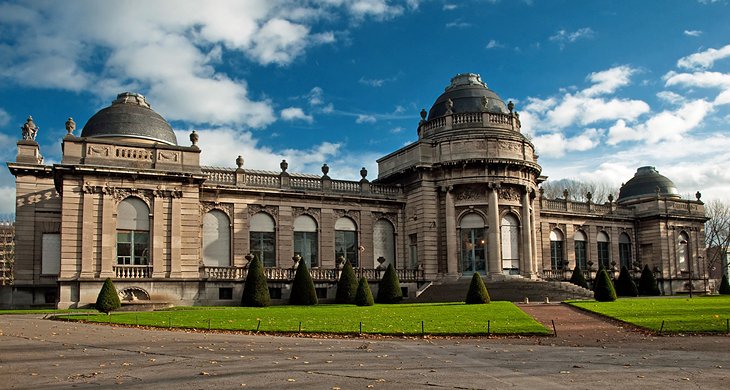
The Museum of Walloon Life (Musée de la Vie Wallonne) is housed in a former 17th-century Minorite monastery.
Inside, you'll find 350,000 exhibits and documents illustrating the life and culture in the Walloon region of Belgium, which have been curated using state-of-the-art museum technology.
The former chapter house on the ground floor houses temporary exhibitions, while the rooms on the first floor are each dedicated to different themes, including religion, festivals, and craft work.
The upper floor is devoted to agricultural crafts, such as cheese making and basket making, and to coal mining in Wallonia, while in the basement is a reproduction of a coal mine tunnel from around 1900.
The museum frequently hosts traditional Walloon puppet theatre (Théâtre de Marionnettes) performances in French and Walloon only.
Address: Court des Mineurs, central Liège
Official site: https://www.provincedeliege.be/en/viewallonne
Church of Saint-Barthélemy

This church was built in the 11th to 12th centuries and extended in the 18th century, with its two towers characteristic of Rhine and Mosan Romanesque church architecture. The late 11th-century choir is of particular interest as are the paintings by Bertholet Flémalle (1614-1675) and Englebert Fisen (1655-1733), who were both from Liège.
The church's most valuable treasure is the bronze font cast by Renier de Huy, which was made between 1107 and 1118. It rests on 12 bulls, symbolizing the Apostles, and is splendidly decorated with five baptismal reliefs.
Originally, the font stood in the Notre-Dame-aux-Fonts church, which was destroyed during the French Revolution and was brought to its present location here to protect it for posterity.
Address: Rue des Brasseurs, central Liège
Check Out the Palais des Princes-Evêques
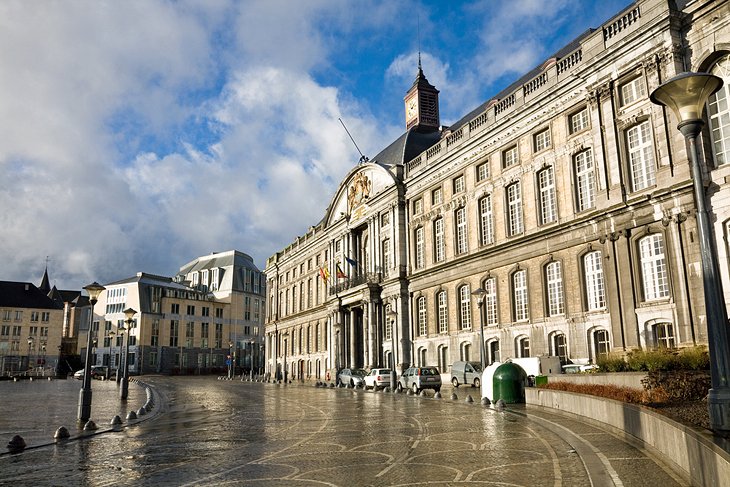
This building – now housing the Law Courts and the seat of the Walloon government – is the former palace of the prince-bishops.
The original building was destroyed at the end of the 15th century, and the reconstruction, which took place between 1526 and 1540, marks the transition between the Gothic and Renaissance style.
There are two picturesque courtyards with arcaded walkways and columns. The artists who carved the columns with fools' masks and grotesque faces were inspired by Sebastian Brant and Erasmus and news from the New World. The second courtyard is more peaceful with a fountain.
The palace interior is not open to visitors, so you can only admire the fine exterior. The buildings and square are especially charming at night when they are softly illuminated.
Address: Place Saint-Lambert, central Liège
Stroll Down Féronstrée
This street runs from the east side of Liège market square through the heart of the Old Town to the Church of Saint-Barthélemy. Its name is a reminder that in the Middle Ages, the forges, iron foundries, and the offices of the metal merchants, together with the guilds' meeting houses, were all found here. Most of the buildings that escaped demolition are from the 18th century.
About halfway along this street is the Ilôt Saint-Georges Complex with the Museum of Walloon Art (Musée de l'Art Wallon), which exhibits paintings, sculptures, and drawings by Walloon artists such as Joachim Patinir, Lambert Lombard, Henri Blès, and Jean Delcour.
A short distance past the Ilôt Saint-Georges is the beautiful facade of the Michel Willems House, built from 1735 to 1740 for Michel Willems, a patrician of the town. Converted into a museum, the house is an eloquent example of the bourgeois lifestyle of the nobility in the 18th century, with an ornate interior that is well worth a look.
Lesser-known, arguably more impressive, is the historic Rue Hors-Château, which runs parallel to Féronstrée. It is known for its hidden dead-end alleys, referred to locally as "impasses," and courtyards, many of which have been beautifully restored.
Address: Féronstrée, central Liège
Enjoy Riverside Life beside the Meuse
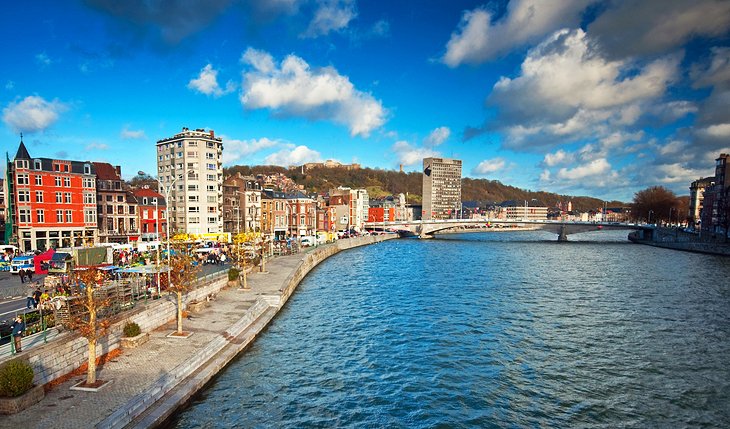
The best place for a stroll in Liège is along the banks of the Meuse River. The Pont des Arches bridge here was built between 1858 and 1862 to replace the older 11th-century bridge.
Between the Rue du Pont and the Rue de la Halle aux Viandes, you'll find the Meat Hall, built in 1546. Behind it, on the corner of Rue de la Boucherie, is the historic inn of Maison Havart, which dates from 1594.
The riverbank leads down to the city quays. Avid shoppers should definitely head to Quai de La Batte (La Batte Quay), where you'll find the daily Batte Market. For the best haggling results, go between 9am and noon. Every Sunday, you'll also find a flea market here.
Address: Meuse canal bank, central Liège
Admire the Architecture of Place de la République
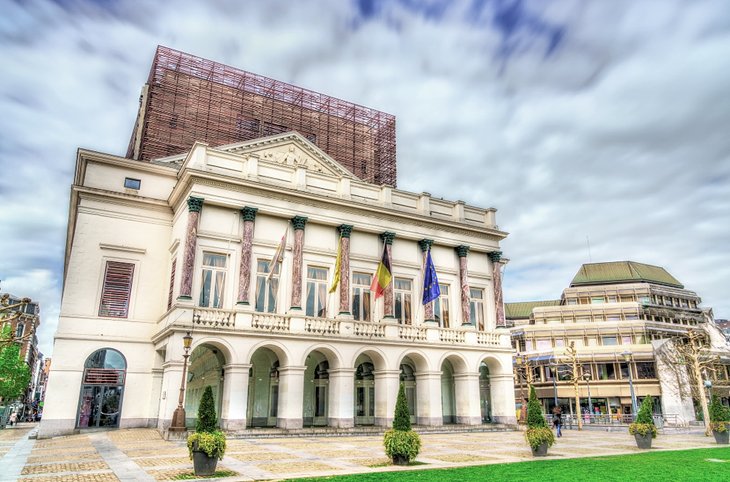
This central plaza, Place de la République, is surrounded by some excellent architecture. Built between 1818 and 1822 and modeled on the Odéon in Paris, the Theatre Royal, on the southwest side of the square, is home to the Opéra Royal de la Wallonie.
Just north of the square, on the corner of the Rue Haute Sauvenière, you'll come to the Church of the Holy Cross, which was consecrated in 979 by Bishop Notker and rebuilt several times. It is one of the few churches in Belgium with two apses: the Romanesque west choir is from 1175, while the Gothic east choir (and the nave) are from the 14th century. The Treasury here contains two exceptional pieces that you definitely shouldn't miss if you're interested in religious art.
The first piece is the Triptych of the True Cross, probably by Godefroid de Huy, into which four fragments of Christ's cross, a piece of John the Baptist's skull, and a tooth of St. Vincent were worked. The second piece is a 37-centimeter-long Clef de Saint-Hubert (St. Hubert's key), which Pope Gregory II gave to St. Hubert in 722 in accordance with a custom of giving great churchmen a key to St. Peter's tomb in Rome, into which a piece of Peter's chain had been inserted.
Ancient history buffs take note, the Archéoforum de Liège, located near Place de la République and beneath Place Saint-Lambert, is an underground archaeological site that reveals a portion of the city's history, from Roman settlements to medieval structures, at the site of the former cathedral.
Address: Place de la République, Liège
Basilique Saint-Martin

On a hill above town, the Basilica of Saint Martin (Basilique Saint-Martin) is visible from afar. Founded in the 10th century and destroyed by fire in 1312 during the disputes between the guilds and the nobility, it was rebuilt in its present form at the beginning of the 16th century with a large star-covered choir.
The church has stained-glass windows dating from 1526 to 1536 and 14 marble plaques in the first side chapel on the right by Delcour commemorating the initiation of the feast of Corpus Christi (Fête-Dieu), which was first celebrated in 1246.
Address: Rue Mont Saint-Martin, Liège
Visit St. Jacob's Church
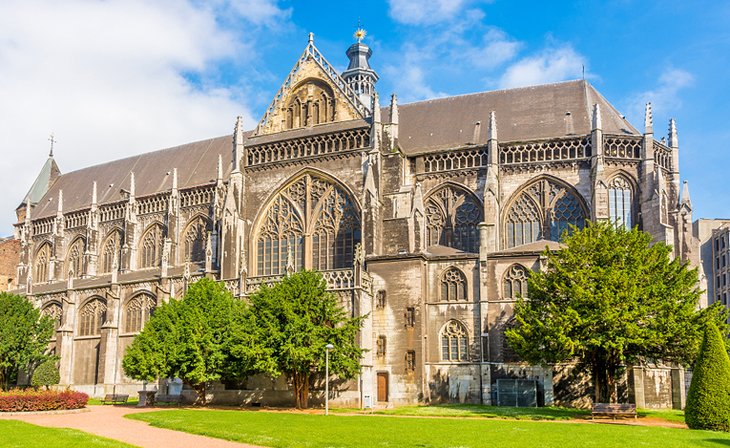
St. Jacob's Church (Saint-Jacques) was founded in the 11th century and converted to a splendid example of late Gothic architecture from 1513 to 1538.
The Romanesque portico of 1170 on the west side has been preserved, while the magnificent north portal was remodeled by Lambert Lombard in Renaissance style from 1558 to 1560, but still has the relief below the arch of the Coronation of the Virgin that was made in 1380 and is considered a masterpiece of Mosan Gothic sculpture.
Also worth seeing inside the church are the superb vaulting, the 17th-century rood-screen, and the 16th-century stained glass work.
Address: Rue St-Remy, Liège
Road Trip to the Ourthe Valley
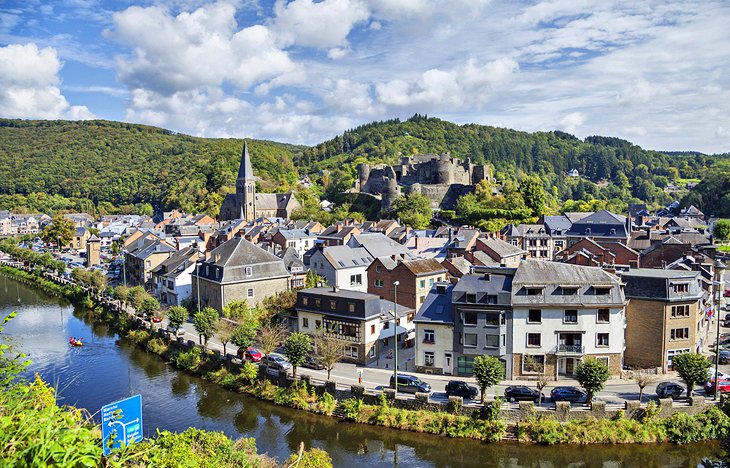
The Ourthe is a 130-kilometer-long river in eastern Belgium, about 69 kilometers south of Liège, and its valley is one of the most charming and picturesque regions in the country. The villages along the riverbank are ideal bases for walks in the forest and trips in boats and canoes on the Ourthe and its tributaries.
There are castles, old windmills, and gorgeous scenery all along the river's route.
In particular, the town of La Roche-en-Ardennes, known as the "Pearl of the Ardennes," has an extremely picturesque location surrounded by forests at the junction of several lateral valleys, while the village of Durbuy is a charming place of narrow streets and old houses, which give the impression that time stands still here.
Liège-Guillemins Railway Station
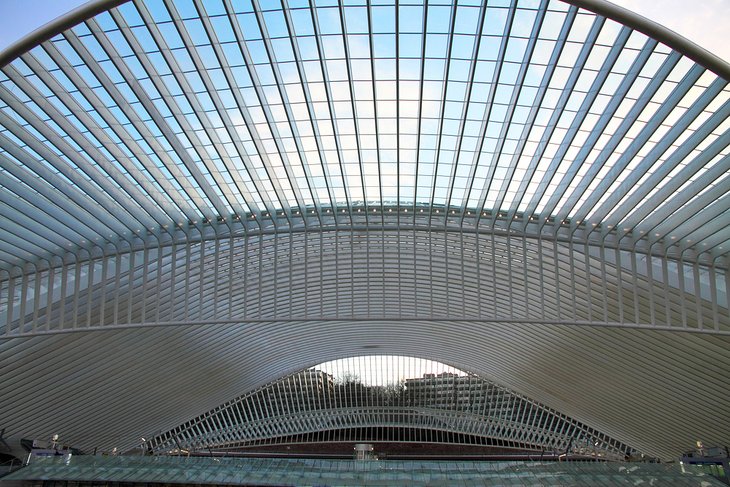
Belgium is full of historic architecture to admire, so make a point of taking some time to check out some of its more interesting contemporary buildings. Liège-Guillemins railway station (Gare de Liège-Guillemins) was built in 2009 and is the work of Spanish architect Santiago Calatrava, best known for his design of the Opera House and City of Arts and Sciences in Valencia.
The station's main feature is its swooping and vast steel, glass, and white concrete vaulted arched roof, which gives the building a cathedral-like ambience. It rises to 32 meters high and is 160 meters long.
If you've arrived by train, the station is a grand entrance into the city.
Address: Place des Guillemins
Day Trip to Stavelot
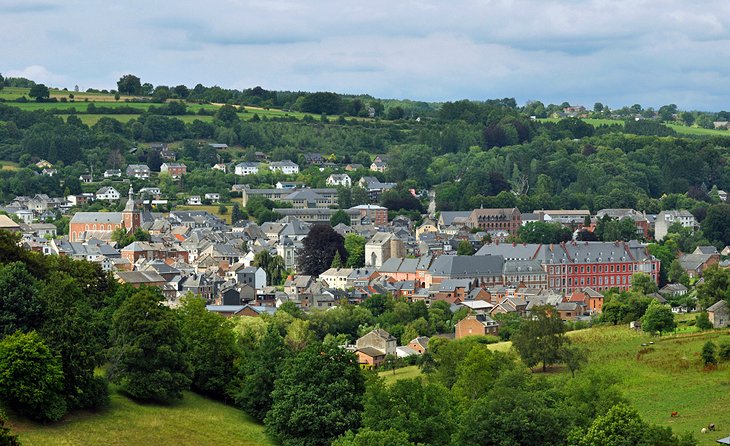
About 68 kilometers southeast of Liège, the town of Stavelot is a tranquil place.
The major tourist attraction here is the Abbey of Stavelot, which was in existence until the French Revolution, when it was dissolved. Today, the premises, which primarily date from the 18th century, house the town administration and three brilliant museums.
The regional Museum of Religious Art is accommodated in the west wing, which was built in 1714.
The Romanesque vaulted cellars of the abbey make an extraordinary setting for a Car Museum.
The third museum (in the abbey's east wing) is dedicated to the French poet Guillaume Apollinaire (1880-1918) who spent three months in Stavelot during 1899 and left town without paying his hotel bill.
Take a Dip in the Waters of Spa
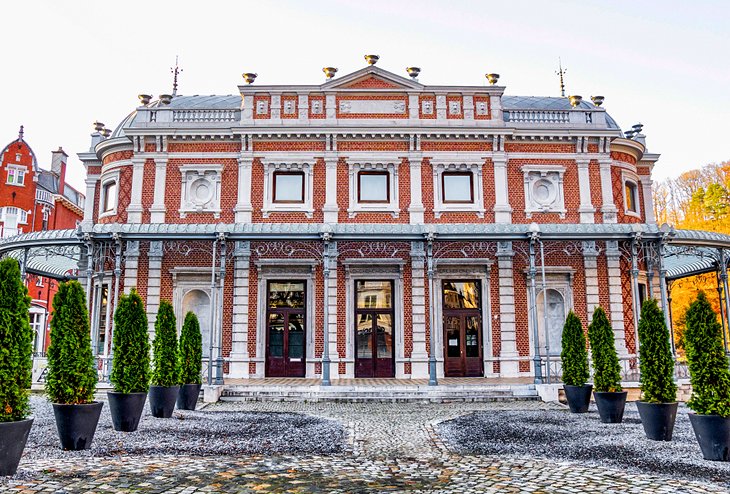
The health resort of Spa, on the wooded slopes of the northern Ardennes, 35 kilometers south of Liège, owes its fame to natural springs which, during the Victorian age, attracted travelers from across Europe. Due to its fame as a health resort, the word "spa" itself became synonymous with a health resort in English.
Today, only the old baths themselves and a few of the hotels remain from its elegant heyday, although people still come here seeking a cure in the iron-rich spring waters.
The life of the spa is principally concentrated in the Place Royale around the baths and the assembly rooms built by Léon Suys from 1862 to 1868. The baths are provided with water from the Marie-Henriette Spring outside town.
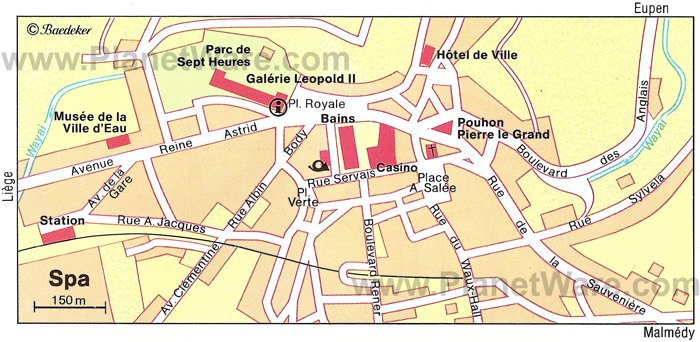
Map of Attractions & Things to Do in Liège
Liege, Belgium - Climate Chart
| Average minimum and maximum temperatures for Liege, Belgium in °C | |||||||||||
| J | F | M | A | M | J | J | A | S | O | N | D |
| 11 -9 | 12 -7 | 17 -4 | 21 -2 | 25 2 | 29 6 | 31 8 | 30 8 | 26 5 | 22 0 | 16 -4 | 12 -8 |
| PlanetWare.com | |||||||||||
| Average monthly precipitation totals for Liege, Belgium in mm. | |||||||||||
| 58 | 53 | 64 | 53 | 64 | 74 | 71 | 66 | 56 | 61 | 69 | 74 |
| Average minimum and maximum temperatures for Liege, Belgium in °F | |||||||||||
| J | F | M | A | M | J | J | A | S | O | N | D |
| 51 15 | 53 19 | 62 24 | 70 29 | 77 35 | 83 41 | 87 45 | 86 45 | 79 40 | 72 32 | 60 25 | 54 18 |
| PlanetWare.com | |||||||||||
| Average monthly precipitation totals for Liege, Belgium in inches. | |||||||||||
| 2.3 | 2.1 | 2.5 | 2.1 | 2.5 | 2.9 | 2.8 | 2.6 | 2.2 | 2.4 | 2.7 | 2.9 |
More Related Articles on PlanetWare.com
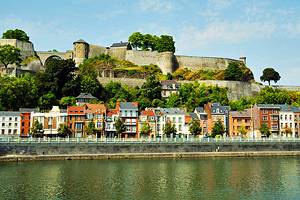
The Citadel of Namur: Another Belgian city with a historic citadel is Namur (Namen), now known for its university. Tourists can explore the old citadel's underground passages, barracks, and grounds, as well as visit the arms museum. The city's old town and Cathedral of Saint Aubain display some beautiful architecture.

Taste of the Netherlands: Liège sits close to the Netherlands border, and is less than 30 minutes' drive to the city of Maastricht. Maastricht is full of historic landmarks, with a romantic old town and beautiful medieval churches; it is also home to several excellent museums.
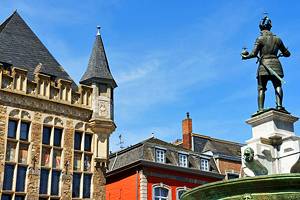
Romantic German Getaway: Germany's westernmost city of Aachen sits close to the Belgian border in the foothills of the Ardennes. Along with the natural hot springs, which first brought visitors to the town centuries ago, Aachen's top tourist attractions include an impressive cathedral with numerous relics and treasures.
